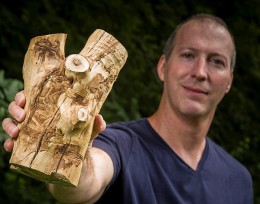Excerpt

Wright State biology professor Don Cipollini suggests use of white fringetree by emerald ash borer is likely to be widespread and that the beetle may move to close relatives.
A team of researchers from Ohio’s Wright State University has discovered that the invasive Emerald Ash Borer (EAB) is capable of completing development on olive trees, making it the second official non-ash species of plant that can host the insect. While EAB previously only posed a threat to forests and landscapes, this latest discovery reveals that it could have negative consequences for olive trees should an invasion occur.
Research into EAB’s ability to make a home out of the cultivated olive (or Olea europaea) was led by Don Cipollini, professor of plant physiology and chemical ecology at Wright State University.
The findings were published in the Journal of Economic Entomology. It builds off previous studies first initiated in 2014, where the team explored its attacks on white fringetree (Chionanthus virginicus), which is a relative of the ash tree.
Cultivated olive trees are a close relative of the white fringetree and are known to grow in areas where susceptible ash trees have been cultivated and grown. In initial studies, tests were done on the tree using EAB eggs sourced from insects with no previous exposure to either olive or white fringetree in order to reveal the true innate potential of the EAB to use alternative hosts without having an adaptive advantage.
The current study involved the researchers using the Manzanilla cultivar of olive and placing eggs directly on cut stems. It was discovered that larvae were capable of feeding and growing to adulthood on the tree, although not at the same level as that seen on most North American ash trees or white fringetree.
The findings revealed that the potential host range of EAB is broader than previously thought and if the insect can detect and utilize olive trees, it could make the leap to become a pest of the crop. As olive trees are already vulnerable to several pathogens and insects, it could make them more vulnerable to EAB. This would make its potential spread and persistence more likely.
According to Cipollini, the outcomes of the EAB becoming a pest of the olive tree would require serious action from all involved parties. “If the EAB can detect and utilize olive trees in the field, then it could have negative consequences on growth and productivity of olive trees. Treatment and management protocols will need to be established for it,” he said.
Read the entire story at oliveoiltimes.com

 Milling around
Milling around  Wright State recognizes Nursing Professor Kim Ringo for advancing international student success
Wright State recognizes Nursing Professor Kim Ringo for advancing international student success  Wright State honors graduating students for distinguished doctoral dissertations
Wright State honors graduating students for distinguished doctoral dissertations  Top 10 Newsroom videos of 2025
Top 10 Newsroom videos of 2025  Museum-quality replica of historic Hawthorn Hill donated to Wright State
Museum-quality replica of historic Hawthorn Hill donated to Wright State 